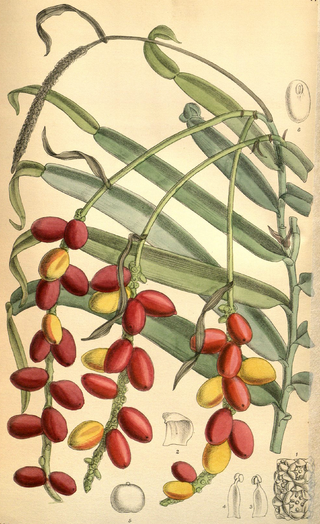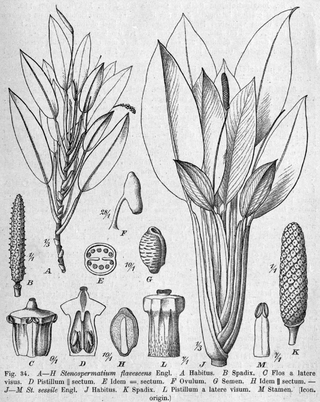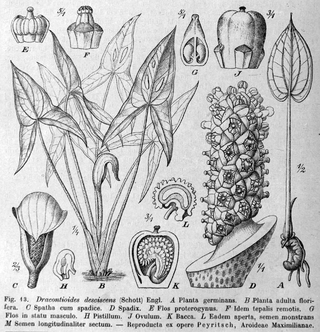
The Araceae are a family of monocotyledonous flowering plants in which flowers are borne on a type of inflorescence called a spadix. The spadix is usually accompanied by, and sometimes partially enclosed in, a spathe. Also known as the arum family, members are often colloquially known as aroids. This family of 140 genera and about 4,075 known species is most diverse in the New World tropics, although also distributed in the Old World tropics and northern temperate regions.

Peltandra, the arrow arums, is a genus of plants in the family Araceae. It is native to the eastern United States, eastern Canada, and Cuba.
- Peltandra sagittifolia - (Michx.) Morong - Spoon flower or the white arrow arum - southeastern US from eastern Louisiana to Virginia
- Peltandra virginica(L.) Schott - Arum arrow - Cuba, Quebec, Ontario, Oregon, California, Washington; eastern US from Maine to Florida, west to Texas, Kansas, and Minnesota
- †Peltandra primaeva – Eocene, Golden Valley Formation, North Dakota, USA

Heinrich Gustav Adolf Engler was a German botanist. He is notable for his work on plant taxonomy and phytogeography, such as Die natürlichen Pflanzenfamilien, edited with Karl A. E. von Prantl.

Pothos is a genus of flowering plants in the family Araceae. It is native to China, the Indian Subcontinent, Australia, New Guinea, Southeast Asia, and various islands of the Pacific and Indian Oceans.

Heteropsis is a genus of plants in the family Araceae, native to Central and South America.

Rhaphidophora is a genus in the family Araceae, occurring from tropical Africa eastwards through Malesia and Australasia to the Western Pacific. The genus consists of approximately 100 species.

Rhodospatha is a genus of plant in family Araceae. It is native to South America, Central America, and southern Mexico.

Stenospermation is a genus of plant in family Araceae native to South America and Central America.

Epipremnum is a genus of flowering plants in the family Araceae, found in tropical forests from China, the Himalayas, and Southeast Asia to Australia the western Pacific. They are evergreen perennial vines climbing with the aid of aerial roots. They may be confused with other Monstereae such as Rhaphidophora, Scindapsus and Amydrium.

Ambrosina is a genus in the family Araceae that consists of only one species, Ambrosina bassii, and the only genus in the tribe Ambrosineae. This species is the smallest aroid in the Mediterranean, growing only to 8 cm tall. It is usually found growing in woodlands on north faces of hillsides and in humus soil that is covering limestone. It is distributed in Sardinia, Corsica, Sicily, southern mainland Italy, Tunisia, and Algeria.

Biarum is a genus of flowering plants in the family Araceae. It is composed of plants that are native to the Middle East, southern Europe, and North Africa. Biarum are often found growing in rock crevices and graveled soil composed largely of limestone.

Stylochaeton is a genus of flowering plants in the family Araceae that is endemic to Africa. Stylochaeton are rhizomatous with hastate leaves. Flowering in this genus is said to be quite uncommon. Stylochaeton is the sole genus in the tribe Stylochaetoneae.

Aroideae is a subfamily of flowering plants in the family Araceae. It is the largest subfamily in Araceae and consists of about 72 different genera, and 2,300 species. Many Aroideae have spiny pollen grains without a sporopollenin outer exine layer and lacking an aperture.

Urospatha is a genus of flowering plants in the family Araceae that consists of approximately 10 known species. They are found growing in South America and Central America in swamps, wet savannahs, and brackish water. The leaves of the species in this genus are upward pointing and sagittate (arrow-shaped). The inflorescences are quite unique; the spathe is mottled and elongated with a spiral twist at the end. The seeds are distributed by water and have a texture similar to cork that allows them to float. They also quickly germinate in water.

Dracontioides is a genus of flowering plants in the family Araceae. It was long thought to contain only a single species until a second species was described in 2005. Both are endemic to Brazil.

Cercestis is a genus of flowering plants in the family Araceae. The species in this genus are all climbers and are endemic to Africa. At intervals along the stem they produce long leafless shoots called flagella. Many of the species in Cersestis show signs of fenestration.

Culcasia is a genus of flowering plants in the family Araceae, native to tropical Africa. Most of its species are climbers and resemble Cercestis, except that they do not produce flagella.
- Culcasia angolensisWelw. ex Schott - western + central Africa from Senegal to Angola
- Culcasia annetiiNtépé-Nyamè - Ivory Coast, Cameroon, Liberia
- Culcasia bosiiNtépé-Nyamè - Cameroon, Gabon, Congo-Brazzaville
- Culcasia brevipetiolataBogner - Gabon
- Culcasia caudataEngl. - Zaïre
- Culcasia dinklageiEngl - western + central Africa from Liberia to Zaïre
- Culcasia ekongoloiNtépé-Nyamè - central Africa from Nigeria to Zaïre
- Culcasia falcifoliaEngl. - central Africa from Gabon east to Tanzania and south to Mozambique
- Culcasia glandulosaHepper - Ivory Coast, Sierra Leone, Liberia, Congo-Brazzaville
- Culcasia insulanaN.E.Br. - Zaïre, Cameroon, Gulf of Guinea Islands
- Culcasia lanceolataEngl. - Cameroon, Gabon
- Culcasia libericaN.E.Br. - Ivory Coast, Sierra Leone, Liberia, Togo
- Culcasia linearifoliaBogner - Cameroon, Gabon
- Culcasia loukandensisPellegr - Cameroon, Gabon, Congo-Brazzaville, Zaïre, Central African Republic
- Culcasia mannii(Hook.f.) Engl. - Cameroon, Gabon, Congo-Brazzaville, Nigeria, Equatorial Guinea
- Culcasia obliquifoliaEngl. - Cameroon, Gabon
- Culcasia orientalisMayo - Kenya, Tanzania, Mozambique, Zambia
- Culcasia panduriformisEngl. & K.Krause - Cameroon, Gabon
- Culcasia parvifloraN.E.Br. - western + central Africa from Liberia to Zaïre
- Culcasia rotundifoliaBogner - Gabon
- Culcasia sanagensisNtépé-Nyamè - Cameroon
- Culcasia scandensP.Beauv. - western + central Africa from Liberia to Angola
- Culcasia seretiiDe Wild - western + central Africa from Liberia to Zaïre
- Culcasia simiarumNtépé-Nyamè - western Africa from Ivory Coast to Cameroon
- Culcasia striolataEngl. - western + central Africa from Liberia to Congo-Brazzaville
- Culcasia tenuifoliaEngl. - western + central Africa from Liberia to Zaïre
- Culcasia yangambiensisLouis & Mullend. - Congo-Brazzaville, Zaïre

Eminium is a genus of flowering plants in the family Araceae. The genus ranges from Turkey and Egypt east to Central Asia. Usually they can be found growing in barren areas in sand or stony soil. The foliage of Eminium resembles Helicodiceros and its inflorescence and fruit resembles those of Biarum.
- Eminium albertii(Regel) Engl. - Turkmenistan, Uzbekistan, Afghanistan
- Eminium heterophyllum(Blume) Schott - Iran, Iraq, Turkey
- Eminium intortum(Banks & Sol.) Kuntze - Turkey, Syria
- Eminium jaegeriBogner & P.C.Boyce - Iran
- Eminium koenenianumLobin & P.C.Boyce - Turkey
- Eminium lehmannii(Bunge) Kuntze - Kazakhstan, Kyrgyzstan, Turkmenistan, Uzbekistan, Afghanistan, Tajikistan
- Eminium rauwolffii(Blume) Schott - Turkey, Syria
- Eminium regeliiVved. - Kazakhstan, Kyrgyzstan, Tajikistan, Uzbekistan
- Eminium spiculatum(Blume) Schott - Egypt, Israel, Palestine, Jordan, Lebanon, Syria, Iraq, Iran

Taccarum is a genus of flowering plants in the family Araceae. It is endemic to South America. The genus tends to grow in rocky areas.
- Taccarum caudatumRusby - Bolivia, Peru, Acre State in western Brazil
- Taccarum crassispathumE.G.Gonç. - central Brazil
- Taccarum peregrinum(Schott) Engl. - Paraguay, southern Brazil, Misiones Province of Argentina
- Taccarum uleiEngl. & K.Krause - eastern Brazil
- Taccarum warmingiiEngl. - southern Brazil
- Taccarum weddellianumBrongn. ex Schott - Bolivia, Peru, Paraguay, central and western Brazil
























